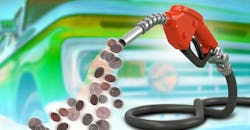Automated control of cars may let “drivers” rack up more fuel savings than if they were completely in charge, according to a new study conducted by the U.S. Department of Energy’s National Renewable Energy Laboratory (NREL) and Volvo Cars. Placing a number on the fuel efficiency of such vehicles is challenging, as fuel economy is typically measured in a lab, but that doesn’t work for automated vehicles, says NREL.
This challenge motivated NREL to develop an objective approach for quantifying real-world efficiency due to automated vehicle technologies. NREL partnered with Volvo Cars to demonstrate the approach. The researchers used on-road data from Volvo vehicles driving around Gothenburg, Sweden and compared fuel efficiency for cars that used adaptive cruise control (ACC) to those that did not. ACC is a partial automation technology that relies on cameras and radar sensors in a vehicle to set its speed and distance from the car in front.
Researchers analyzed data collected from thousands of trips made by motorists driving a Volvo—more than 18,500 trips taken by employees and their family members operating similar Volvo vehicles within the designated analysis area. “One obstacle to research like this is limited availability of real-world travel data from automated vehicles,” says Lei Zhu, a researcher in NREL’s Mobility, Behavior, and Advanced Powertrains Group. “The partnership with Volvo Cars provided a rare opportunity to work with actual vehicle-operation and energy-consumption data in real traffic.”
The fuel economy calculation approach quantifies vehicle fuel efficiency in a wide variety of driving conditions, both when ACC is active and when it is inactive. It then weights each condition’s-fuel efficiency by the amount of driving in each condition to obtain the overall fuel economy for manual vs. ACC operation. Following this procedure, the researchers found using ACC resulted in a 5% to 7% drop in fuel consumption.
Other considerations for automated vehicle fuel use include vehicle type and penetration levels into traffic. For instance, although the ACC vehicles in this study operated mostly around other vehicles with the driver in complete control, simulation studies have shown that lots of ACC vehicles operating together can worsen traffic due to the lag for each vehicle to detect speed changes in the others. So, it is possible that more autonomous cars on the road could make overall traffic flow worse rather than better unless vehicle-to-vehicle communication is included. Another consideration is how much vehicle automation changes the amount or distances people travel.
The innovative fuel economy calculation approach featured in this new study can be applied to simulation studies to study hypothetical “what-if” scenarios, as well as to collect data on the latest vehicle technologies operating in current traffic conditions. Automated vehicles with better data collection and connectivity capabilities could provide better predictions of how on-road fuel economy will be altered by changes in vehicle technology, penetration rates, and the effects of traffic. This kind of information is important for stakeholders and policymakers who want to measure how technology effects transportation energy use, and for automakers who want to get credit for potential fuel-saving features of automated vehicle technologies.

